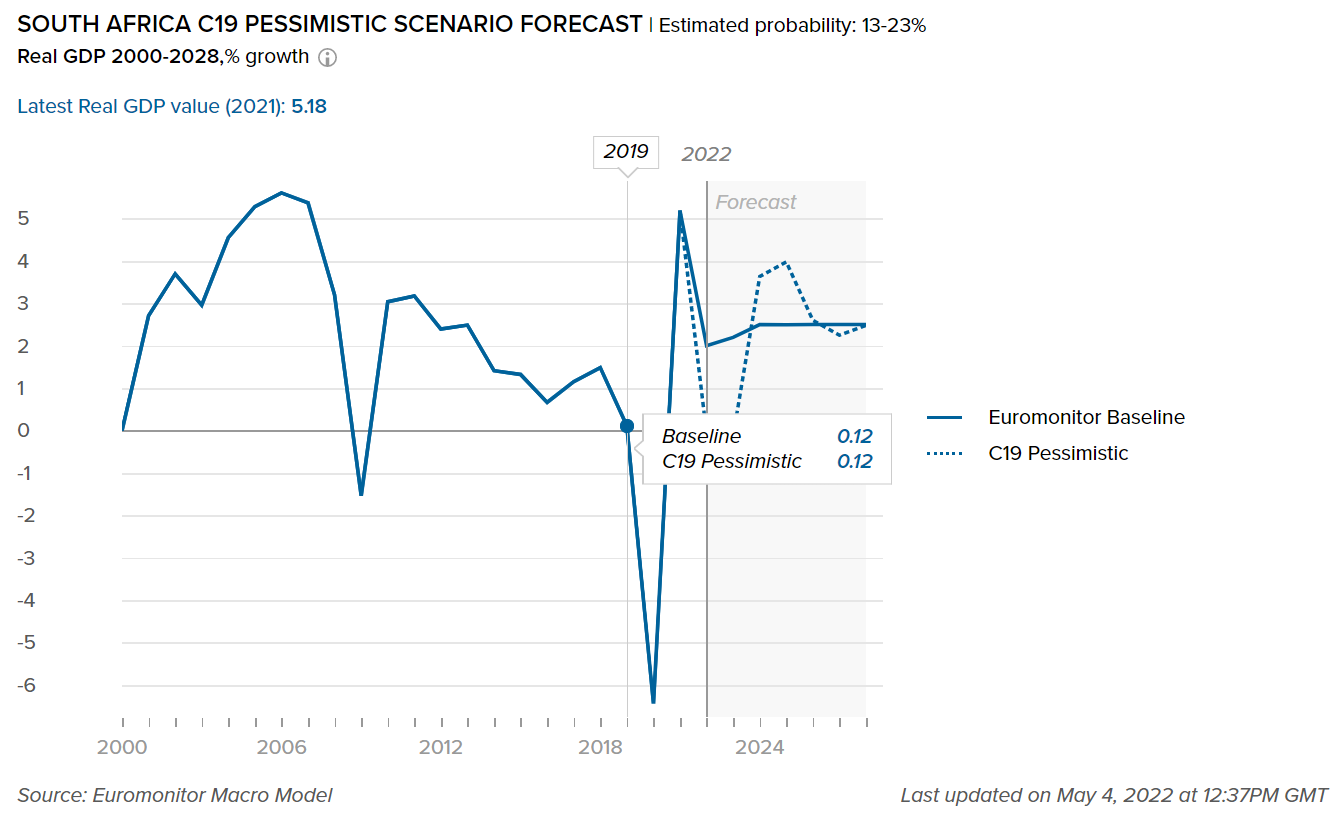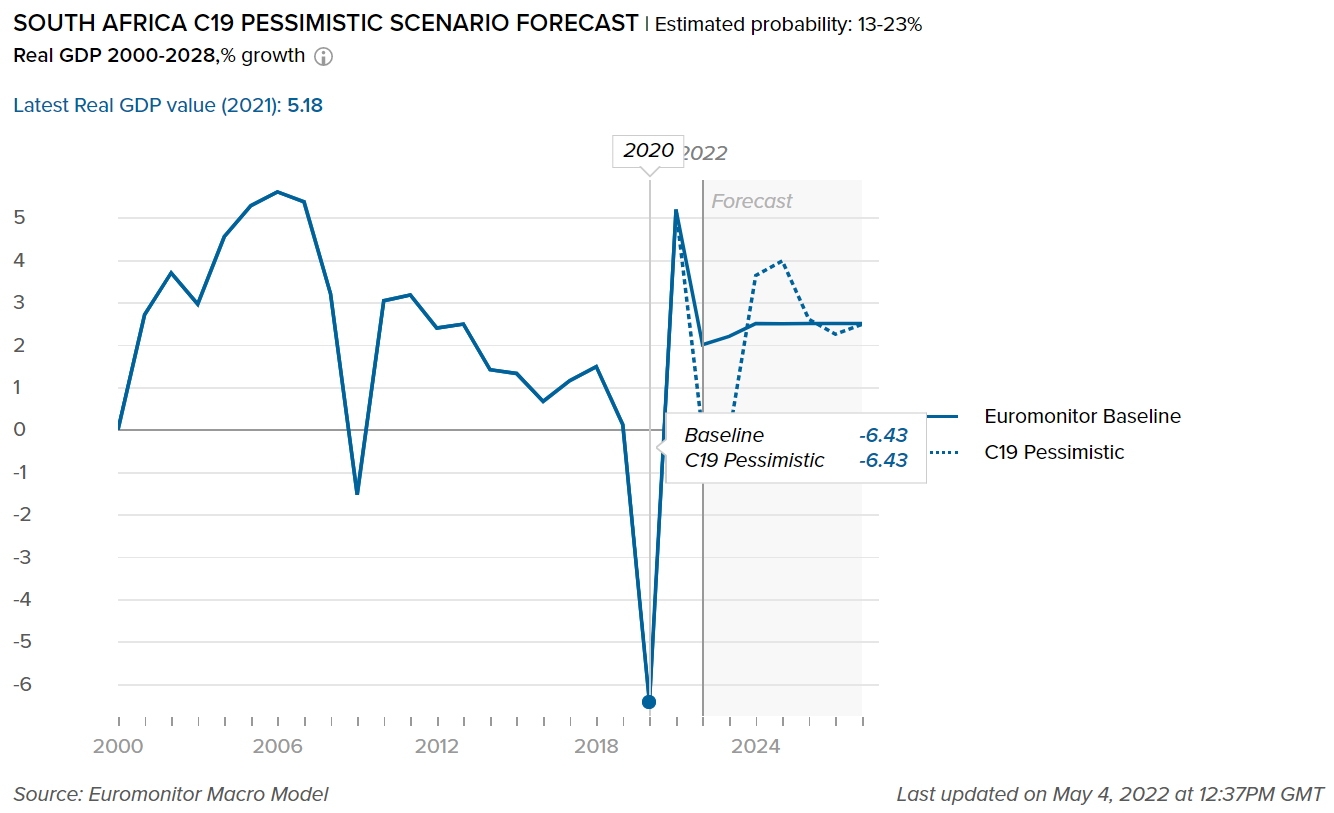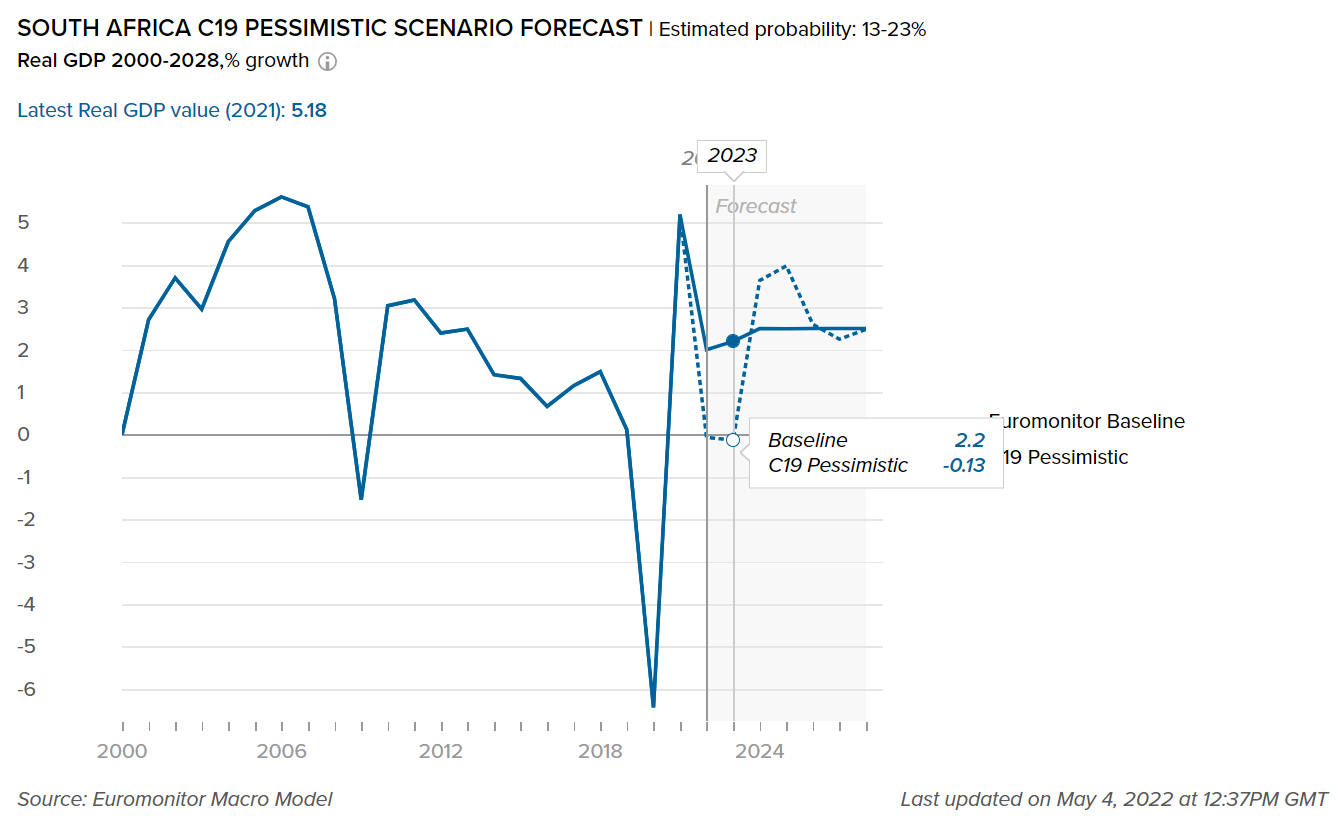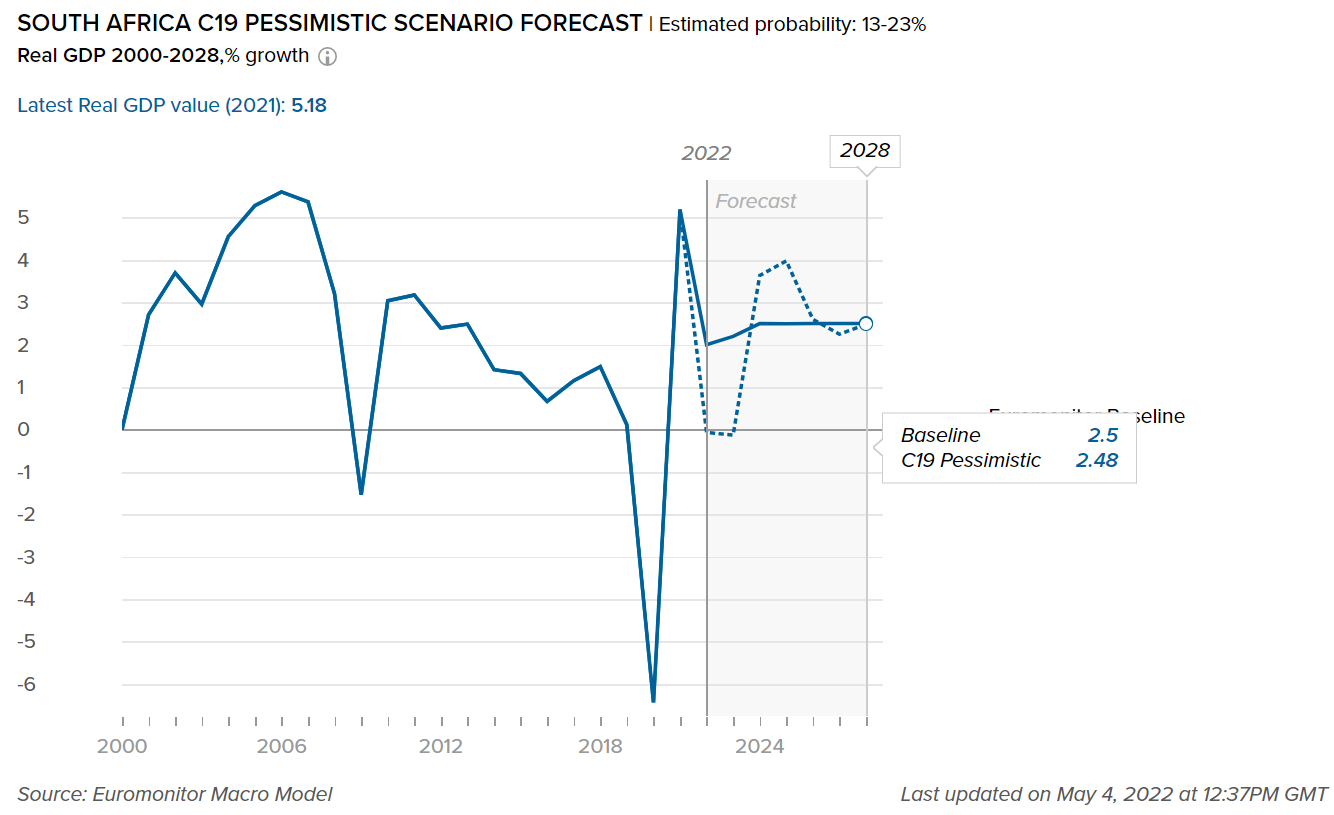Overview
- Packaging Overview
-
2020 Total Packaging Market Size (million units):
29,720
2015-20 Total Packaging Historic CAGR:
2.7%
2021-25 Total Packaging Forecast CAGR:
0.6%
Packaging Industry
2020 Market Size (million units)
Beverages Packaging
12,096
Food Packaging
14,354
Beauty and Personal Care Packaging
1,803
Dog and Cat Food Packaging
167
Home Care Packaging
1,300
Packaging Type
2020 Market Size (million units)
Rigid Plastic
9,379
Flexible Packaging
8,815
Metal
3,878
Paper-based Containers
1,984
Glass
3,927
Liquid Cartons
1,738
- Key Trends
-
The South African economy, which was already in recession before the pandemic, suffered a huge impact due to lockdown restrictions imposed to curb the spread of the virus. Therefore, price is the most important factor for a purchase decision. Rising unemployment and inflation left consumers cash-strapped and less expensive, and light pack types like flexible plastic and plastic pouches are expected to be the leading packaging formats for beauty and personal care products, dishwashing products, and baby food among others. Apart from this trend, the popularity of e-commerce websites will also drive the trend in the packaging industry.
- Packaging Legislation
-
The packaging industry in South Africa saw various regulations in recent years. The R991 law covers the advertising and labeling of milk formula and places significant constraints on the promotion of such products. Tamperproof packaging has been made mandatory and health and nutrition claims have been banned. Manufacturers are also required to show the message “Breast milk is the best for infants” on product packaging to promote breastfeeding.
- Recycling and the Environment
-
Although players in the packaging industry are doing their part to come up with eco-friendly packaging solutions, the weak South African economy and depleting disposable income is becoming an impediment in this journey towards recyclability and sustainability. Woodlands Dairy, a leading manufacturer of UHT (ultra-high temperature processed) milk in South Africa came up with a format made from plant-based materials and is 100% recyclable. The introduction of the carbon tax in 2019 will further force manufacturers to innovate their processes and packaging materials to reduce their carbon footprint.
- Packaging Design and Labelling
-
Laws relating to product claims on the labeling of the product are very strict in South Africa and certain claims like an ingredient providing health benefit cannot be made by the manufacturers. For example, on the labeling of the product, the claim like “contains zinc” can be added but claims like “zinc aids in boosting immunity” cannot be made. As a result, businesses are increasingly relying on images to convey information to customers, a trend that has gained traction during the pandemic as people seek solutions that would help them stay healthy.
Click here for further detailed macroconomic analysis from Euromonitor
- Definitions
-
- Beauty and Personal Care Packaging: This is the aggregation of packaging for baby care, bath & shower products, deodorants, hair care, color cosmetics, men's grooming products, oral hygiene, perfumes & fragrances, skincare, depilatories, and sun care. Black market sales and travel retail are excluded.
- Dog and Cat Food Packaging: This is the aggregation of dog and cat food packaging.
- Packaged Food Packaging: This is the aggregation of packaging for baby food, Bakery, canned/preserved beans, canned/preserved fish/seafood, canned/preserved fruit, canned/preserved meat and meat products, canned/preserved tomatoes, canned/preserved vegetables, other canned/preserved food, confectionery, chilled fish/seafood, chilled lunch kit, chilled processed meats, fresh cut fruits, dairy, dessert mixes, rice, frozen bakery, frozen desserts, frozen meat substitutes, frozen processed fish/seafood, frozen processed potatoes, frozen processed poultry, frozen processed red meat, frozen processed vegetables, other frozen processed food, ice cream, meal replacement, noodles, oils and fats, pasta, ready meals, sauces, dressings and condiments, snack bars, soup, spreads and sweet and savory snacks.
- Home Care Packaging: This is the aggregation of packaging for laundry care, dishwashing products, surface care, chlorine bleach, toilet care, polishes, air fresheners, and insecticides.
- Beverages Packaging: Beverage packaging is the aggregation of alcoholic drinks packaging, hot drinks packaging, and soft drinks packaging.
Beverages
- Overview
-
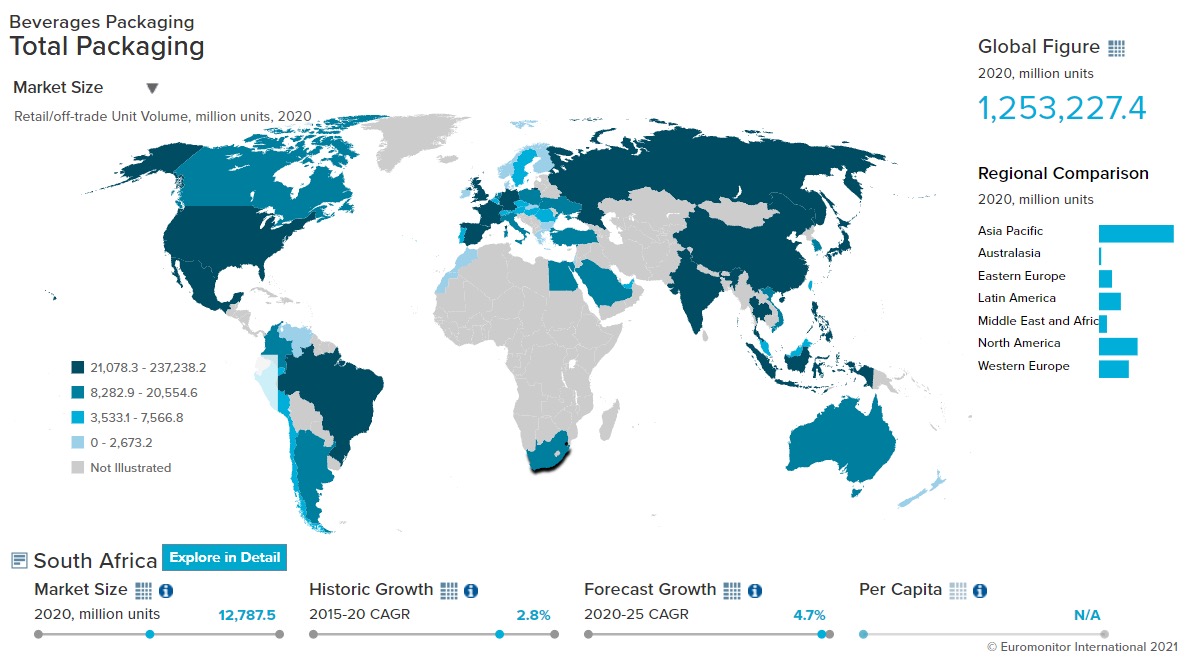
- Flexible Packaging Landscape
-

- The COVID-19 induced economic uncertainty made people prioritize their spending towards less expensive options, which made them price sensitive. This increased the demand for cheaper flexible packaging formats like flexible aluminum/plastic that showed a strong volume growth of 9.2% in 2020.
- Flexible packaging continues to dominate coffee with a volume share of 73.8% in 2020 and volume growth of 10.3% in the same year. This strong growth in 2020 was witnessed due to the increase in at-home consumption of coffee, especially instant coffee, as the pandemic forced the closure of trade establishments.
- Trends
-
- There is a trend of buying multi-packs in soft drinks as it helps in reducing the frequency of trips to the store in the wake of the COVID-19 pandemic. Metal beverage cans benefitted from this trend as they are suitable for multi-packs and provide convenience for storage and transportation. As a result, driven by increased sales in categories like carbonates and energy drinks, metal beverage cans showed a strong volume growth of 6.0% and 6.7% respectively in 2020.
- During the COVID-19 induced lockdown, the South African government banned the transportation and sale of alcoholic drinks within the country. As a result, alcoholic drinks packaging suffered, declining by 16.6% in volume terms in 2020. Since the onset of COVID-19, South Africa has seen 4 periods of alcohol bans, which harmed alcoholic drinks sales in the country.
- Outlook
-
- PET bottles and metal beverage cans recorded a volume share of 60.2% and 22.9% respectively, and are expected to continue to maintain their dominant position in soft drinks packaging over 2021-25. These pack types are suitable to maintain the soft drinks’ specific internal pressure, thereby conserving its taste. Moreover, these pack types are suitable for transportation and storage. As a result, PET bottles and metal beverage cans are expected to record a volume CAGR of 7.1% and 2.7% in soft drinks over 2021-25.
- The uncertain South African economy is expected to continue over 2021-25 and people are expected to be cautious with their spending budget. As a result, at-home consumption of hot drinks is expected, even if the lockdown restrictions ease, because it is a les expensive alternative. This trend will most likely help the growth of the main pack type of hot drinks i.e., flexible aluminum/plastic, which is expected to record a strong volume CAGR of 13.9% over 2021-25.
Click here for more detailed information from Euromonitor on the Beverages Packaging industry
Dog and Cat Food
- Overview
-

- Flexible Packaging Landscape
-
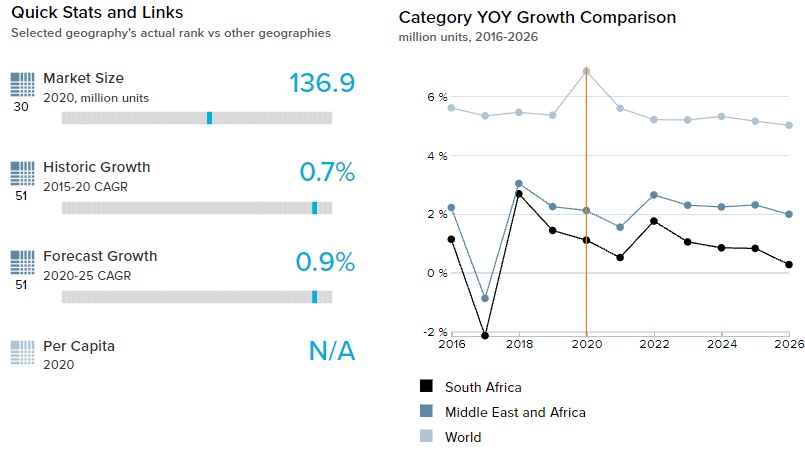
- Flexible packaging continues to dominate dog and cat food with a volume share of over 76.0% in 2020, owing to its lower price point and convenience of storage. This pack type increases the shelf life of the product and prevents moisture from spoiling the product. As a result, flexible packaging like flexible plastic, showed a volume growth of 2.2% in 2020.
- Pet owners are adopting larger packs as it gives a better value for money and reduces frequent visits to the stores. Flexible plastic proves to be the best suited as it can be re-ealed and helps maintain the freshness of the product. As a result, 15kg and 20kg flexible plastic packaging recorded a strong volume growth of 8.9% and 9.0% respectively in 2020.
- Trends
-
- Upper middle- and high-income pet owners who do not mind paying extra to ensure the wellness of their pets are demanding zip/press closures to make sure that pollutants like dust and insects do not enter the food pack. The closure also helps maintain the freshness of the product. To respond to this trend, Dr Hahnz dog food introduced their bag with a sliding zipper in 2020.
- For physically impaired and elderly pet owners, it is difficult to open metal cans. So, in 2020, a large number of new launches in metal food cans started coming with easy-open lids to cater to the demand of these pet owners. Moreover, this closure also proves to be efficient as it does not create a mess while opening and helps save cleaning time.
- Outlook
-
- The economic uncertainty caused by the pandemic is expected to continue over 2021-25 as people are expected to remain price-sensitive and budget-conscious. As a result, larger pack sizes are likely to remain popular among pet owners owing to its lower per-unit cost. Therefore, both 15kg and 20kg flexible plastic is expected to show a volume CAGR of 2.2% and 1.9% respectively over 2021-25.
- Pet owners are becoming increasingly aware of the needs and nutritional requirements of their pets. Therefore, they are looking for products that can cater to their specific needs. As a result, manufacturers are expected to come up with packaging that helps customers know instantly about the ingredients and nutrition of the product by changing the packaging design, labeling, or color scheme. Bob Martin and Nutriphase are among the few manufacturers that responded to this trend. For example, Bob Martin came up with packaging that highlighted nutrients like “22% protein” in large font and different colors. More manufacturers are likely to follow suit.
Click here for more detailed information from Euromonitor on the Dog and Cat food Packaging industry
Beauty and Personal Care
- Overview
-

- Flexible Packaging Landscape
-
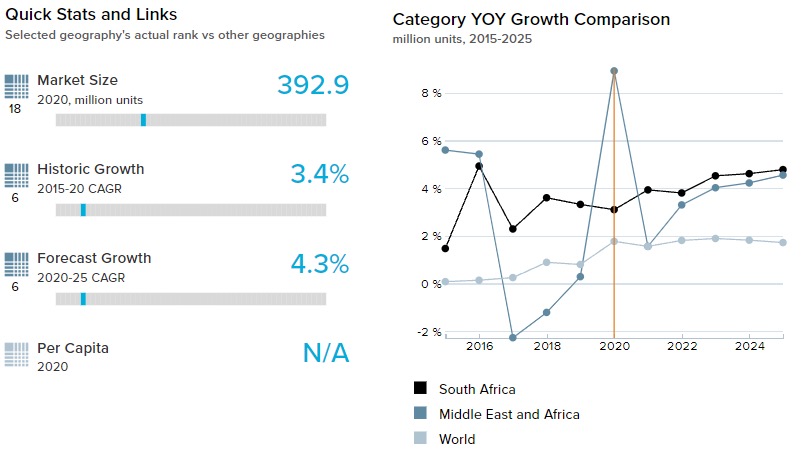
- There has been an increased focus on personal health and hygiene since the onset of the COVID-19 pandemic. This led to increased sales of bath and shower products in South Africa. Owing to this boost in sales, the main pack types of this segment – flexible paper and folding cartons –that recorded a volume share of 26.1% and 40.1% respectively, showed a volume growth of 10.8% and 10.5% in 2020.
- The demand for plastic pouches increased during the pandemic as this pack type is light in weight and is also sold as a refill pack. South Africans perceive refill packs as a good format to stock products at home as it does not get damaged and occupies less shelf space. This helped plastic pouches show a volume growth of 2.8% in 2020 in beauty and personal care products.
- Trends
-
- Even before the pandemic, South Africans considered sun care and color cosmetic products as non-essential items. COVID-19 accelerated this trend as consumers spent much of their time locked away at home. Therefore, the main pack types, specialty cosmetics containers for color cosmetics and HDPE bottles for sun care, showed a volume decline of CAGR 2.6% and 2.8% respectively over 2015-20.
- Rising unemployment, high inflation, and decreasing disposable income made consumers very price sensitive, a trend that was exacerbated during the pandemic. Therefore, people began favoring large pack sizes that provided them better value for money. As a result, 1,500ml and 2,000ml pack sizes showed a volume growth of 3.9% and 4.6% respectively in 2020. But this does not mean that small pack sizes were abandoned, as some people had a very tight spending budget and could not afford spending on costlier larger pack formats in one go. Therefore, smaller pack sizes such as 15ml and 60ml showed a volume growth of 3.0% and 2.5% respectively in 2020.
- Outlook
-
- South Africa struggled from the third COVID-19 wave in mid-2021. Therefore, the focus on personal health and hygiene is expected to remain strong over 2021-25. This means bath and shower products are likely to perform well in this period. Flexible paper and folding cartons are most likely to show a volume CAGR of 8.4% and 4.2% over 2021-25.
- The South African economy has been struggling with the rising cost of living and with the pandemic likely to persist, strong improvement in the economy is not expected over 2021-25. This would likely mean smaller spending budgets, so new innovative, but more costly, sustainable packaging is not likely to become popular over 2021-25. Nevertheless, domestic manufacturers such as Teqal creative packaging have come up with the first biodegradable beauty and personal care container developed locally. The packaging is 70% biodegradable and 100% recyclable and aims to appeal to the high-income environmentally-conscious consumer.
Home Care
- Overview
-

- Flexible Packaging Landscape
-

- Increased at-home consumption of meals due to the lockdown restrictions and work-from-home policies contributed to the strong growth of dishwashing products, which grew 10.2% in volume terms in 2020. As a result, dishwashing products packaging also grew by a volume of 6.0% during the same year. Its main pack type, stand-up plastic pouches, recorded a volume share of 50.5% in 2020 showed a volume growth of 10.7% in the same year. The pouches have a strong appeal by featuring a lower price point and a screw closure for easy usage.
- Flexible packaging, like flexible aluminum/plastic and plastic pouches, showed a strong volume growth of 8.8% and 9.1% in home care products in 2020. This was because they are less expensive than other pack types like glass and metals and are also perceived to be easy to store and suitable for transportation. As a result, manufacturers started using these pack types to provide products at an affordable cost.
- Trends
-
- Due to the threat of the COVID-19 pandemic, there was more time spent at home and an increase in the need for keeping one’s surroundings clean. As a result, the demand for surface cleaners and home insecticides rose and benefitted their common pack types in 2020 such as PET bottles and metal aerosol cans. They showed a volume growth of 4.4% and 1.7% respectively in 2020.
- There is an increasing trend for larger pack sizes of essential items like laundry detergents, as it has a lower per-unit cost and helps in storing products for a longer time without the fear of it being out of stock. As a result, larger pack sizes in laundry care such as 1,000ml HDPE bottles and 5kg flexible aluminum/plastic showed a volume growth of 11.5% and 11.1% in 2020.
- Outlook
-
- Eco-friendly packaging is expected to gain momentum over 2021-25 as manufacturers started investing in its research and development. For example, Woolworths launched its Earth Friendly range in fully recyclable plastic packaging and also introduced a household cleaning range in green plastic HDPE bottles. Unilever aims to ensure that 100% of its packaging is fully reusable, recyclable, or compostable by 2030. Other manufacturers are expected to come up with similar sustainable packaging solutions.
- Refill packs, which are a less expensive alternative for original packaging formats are expected to perform well over 2021-25, as the uncertainty of the economic environment is likely to continue. As a result, plastic pouches that are extensively used as a refill pack, are expected to perform well in the home care segment. This is especially true among dishwashing and surface cleaners, which are likely to show a volume CAGR of 5.9% and 3.8% respectively over 2021-25.
Click here for more detailed information from Euromonitor on the Home Care Packaging industry
Packaged Food
- Overview
-

- Flexible Packaging Landscape
-
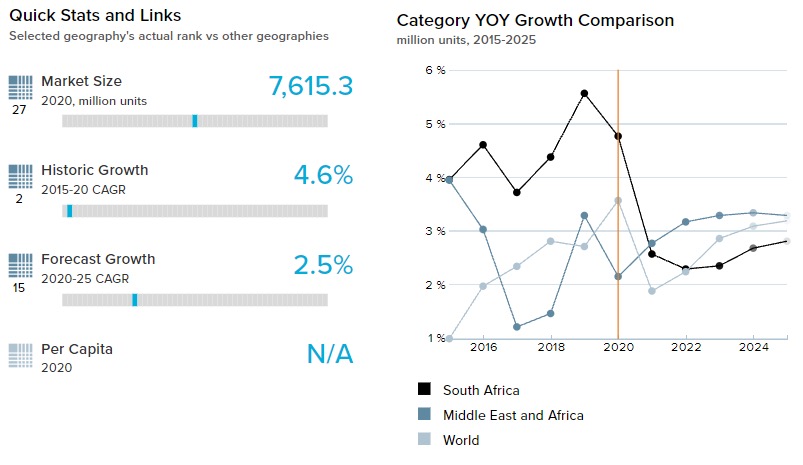
- Flexible packaging continues to dominate confectionery owing to its light weight, ease of storage and transportation, and lower price point that helps make the product affordable. In flexible packaging, flexible plastic dominated the category with a volume market share of over 83.5% and showed a volume growth of 3.7% in 2020.
- In baby food products, pandemic-induced lockdowns shifted the packaging type from glass jars to plastic pouches due to the convenience of transportation offered by plastic pouches as most of the products were ordered online. As a result, glass jars showed a volume decline of 2.5% while plastic pouches showed a volume growth of 7.5% in 2020.
- Trends
-
- When it comes to processed meat and seafood, canned tuna fish performs well as it is a staple for many South African kitchens and is perceived to be affordable and nutritious. This helped metal food cans gain volume share as it is the main pack type, owing to its better storability than other pack types like folding cartons. In 2020, metal food cans recorded a volume share of 67.7% and showed a volume CAGR of 6.6% over 2015-20.
- There is an increased focus on health and wellness due to COVID-19 and this helped the growth of yogurt, sour milk, and processed cheese in dairy products. This is because yogurt and sour milk are believed to improve the immune system, while cheese includes required nutrition such as calcium and protein. As a result, their main pack types, flexible plastic in cheese and thin wall plastic containers in yogurt and sour milk showed a volume growth of 4.9% and 8.6% in 2020.
- Outlook
-
- Rising health and wellness is a trend expected to continue over 2021-25, which can also be seen in the ready meals in South Africa. Players like Clover’s Whistling Chef range introduced pack types that help keep the food fresh for a longer time, thereby increasing the shelf life. The advantage of this will be that the number of preservatives, which are believed to be unhealthy, will be reduced as innovative pack types help reduce the contact of food with moisture. This will keep food fresh for a longer time, thereby reducing the need for preservatives. Over 2021-25, innovation in pack types is expected to stop the use of preservatives altogether, thereby targeting health-conscious consumers.
- The popularity of e-commerce in the baby food segment is expected to increase in South Africa as transportation convenience is expected to be an important purchase factor. As a result, glass bottles, which are not suitable for transportation, are expected to lose share to plastic pouches. The pouches have a lower price point and are easier to store. As a result, glass bottles are expected to show a volume decline at a CAGR of -8.4% while plastic pouches are like to show a strong volume growth at a CAGR of 8.9% over 2021-25.
Click here for more detailed information from Euromonitor on the Packaged Food Packaging industry
RECOVERY FROM COVID
- Overview of COVID-19 conditions in South Africa
-
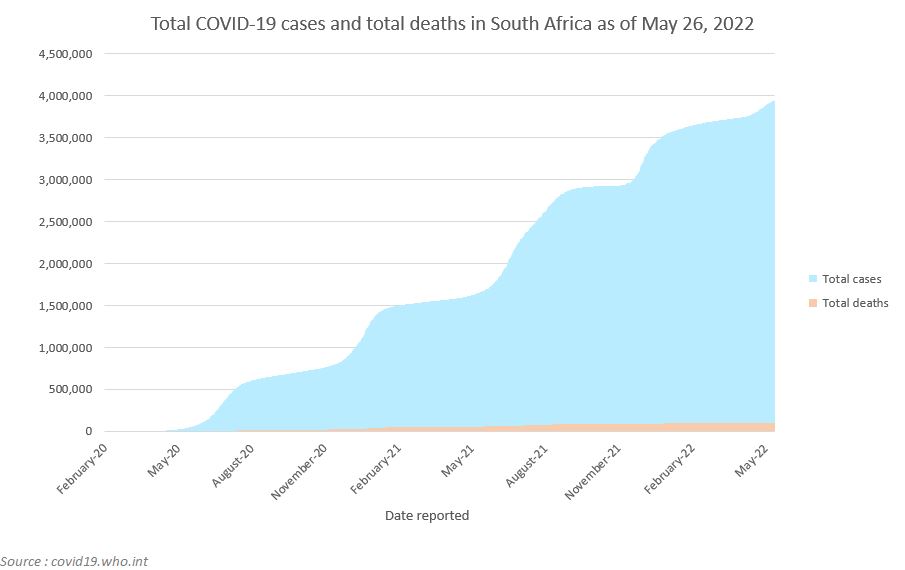
South Africa eases COVID-19 protocols for inbound tourists as the threat of contraction reduces
- According to the World Health Organization (WHO), as of May 26, 2022, South Africa had a total of 3,926,652 COVID-19 cases, 100,931 deaths, and 5,019 new cases.
- South Africa witnessed a fifth wave of COVID-19 in December 2021, with Omicron BA.4 and BA.5 being the two variants that hit the country. However, this wave was not as strong as the previous ones, and hospitalizations, deaths, and new cases were trimmed down. As of May 2022, the fifth wave has almost subsided and there are no expectations for case surges in South Africa, as per the National Department of Health.
- According to the WHO, as of May 22, 2022, South Africa’s total vaccinations reached 35,744,528, accounting for 60.2% of the total population. The percentage of the population that had been fully vaccinated was 33.3%. As per the Employment and Labor Ministry, after the National State of Disaster lapses, South Africans will have to continue to show their vaccination status to their employers, and businesses will have to develop or upgrade COVID-19 risk containment plans if needed.
- As of June 2022, the South African government has decided to drop all of the country’s pandemic-era movement restrictions. As a result, there are no vaccination or testing requirements to enter the country for travelers. Moreover, the nation’s indoor mask mandates and limits on gathering sizes have also been removed.
The chart below shows Euromonitor International’s Recovery Index.
The quarterly reported Recovery Index is a composite index that provides a quick overview of economic and consumer activity. It keeps track of the latest quarterly economic/consumer data and forecasts in key economies to gauge when economic activity and consumer demand are likely to return to the pre-pandemic levels of 2019.
A score of 100 and over indicates a full recovery in which economic output, the labor market, and consumer spending all return to/exceed 2019 levels.
Detailed methodology is provided in the Appendix.Quarterly Recovery Index and Related Indicators, South Africa

- Impact on GDP
-
This graph shows our “most probable” and “worst case” estimate scenarios of how COVID-19 will impact the real GDP value in South Africa. Our “most probable,” or Baseline scenario, has an estimated probability of 45-60% over a one-year horizon. Our “worst case,” or Pessimistic scenario, has an estimated probability of 13-23% over a one-year horizon. For more details, please refer to the detailed explanation of the COVID-19 scenarios in the Scenario Definitions section.
Please note that the forecasts will be adjusted every three months, according to the expected number of cases, recoveries, and deaths due to COVID-19 in this country, as well as shifting socioeconomic conditions (the most recent update was May 2022).
Baseline forecast refers to the “best case” COVID-19 scenario forecast that has an estimated probability of 45-60%.
C19 Pessimistic refers to the “worst case” COVID-19 scenario forecast that has an estimated probability of 13-23%.
South Africa’s GDP is likely to improve over 2022-2026
- South Africa witnessed a decline of 6.4% in 2020 due to the coronavirus pandemic shock. However, GDP in South Africa increased by 5.2% in 2021, outperforming the average growth of 4.1% in the Middle East and Africa region, supported by rising commodity prices and increasing domestic demand. Over 2022-2026, South Africa’s economy is likely to expand at a CAGR of 2.5%, driven by vaccine production. South Africa is also set to become the continent’s main hub for the production of COVID-19 vaccines.
- Over 2022-2026, the total population is likely to increase by 18.8% in South Africa, driven by natural increase and migration. South Africa’s population is expected to reach 71.3 million by 2040, and it will be one of the top 10 most populated countries in the Middle East and Africa region. South Africa’s sizeable populace and rising prosperity are set to make it a progressively more attractive consumer market.
- Urban expansion is also projected to continue at a brisk pace in South Africa and by 2040, a significant 76.2% of the total population is set to be living in urban areas, supported by the plethora of opportunities in urban areas. This is likely to provide prospects for the South African government to upgrade urban infrastructure, create jobs, and boost the construction sector.
- Impact to Sector Growth
-
Please note that the forecasts are adjusted every three months according to the expected number of cases, recoveries, and deaths due to COVID-19 in the country, as well as shifting socioeconomic conditions.
The graph below displays the adjusted forecasts of the percentage growth for the categories mentioned to highlight the impact of COVID-19 between our pre-COVID-19 estimates and the “most probable” (Baseline) forecast which has an estimated probability of 45-60%.
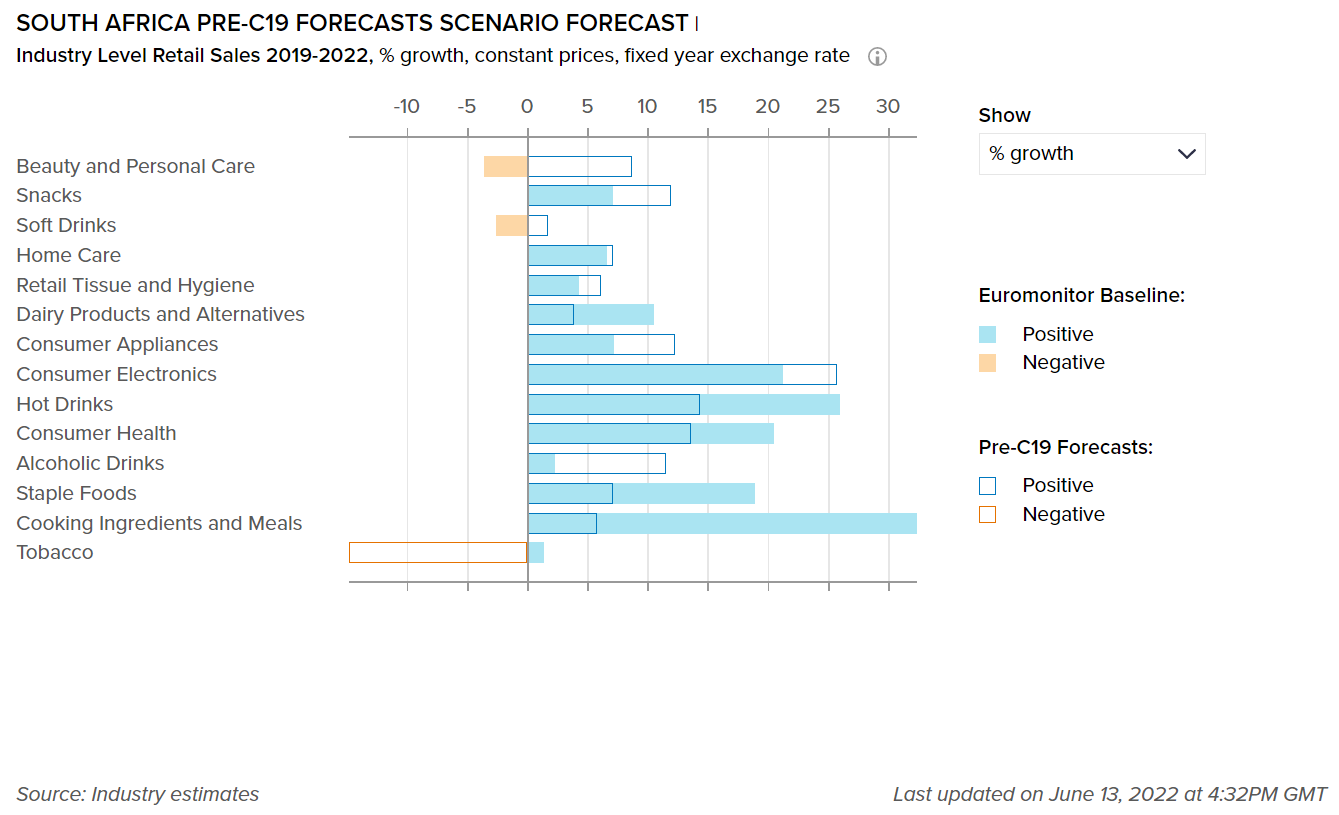
Baseline forecast refers to the “best case” COVID-19 scenario forecast that has an estimated probability of 45-60%.
Focus on natural ingredients is likely to drive the beauty and personal care market over 2022-2026
- As South Africa returns to normalcy, the landscape for beauty and personal care is set to improve over 2022-2026. As the government is set to loosen COVID-19 restrictions and reduce the need to wear protective face masks in public, in-store makeovers and beauty consultations are likely to return to pre-pandemic conditions, which will help improve sales. Hygiene consciousness and a focus on natural ingredients are likely to drive the market over 2022-2026, improving the sales of skincare and bath and shower products. Likewise, the anticipated relaxation of travel restrictions and reopening of public places is set to drive the demand for color cosmetics, deodorants, hair care, fragrances, and sun care.
- Home care in South Africa registered solid growth of 5.9% in 2021, as sales continued to be boosted by the lingering impact of the pandemic. The key subcategories that benefitted were laundry care, dishwashing, bleach, surface care, and toilet care, driven by the cleanliness trend. Increased focus on hygiene helped surface care and toilet care as consumers emphasized making their homes germ-free. Laundry care, the largest category in South African home care, continued to perform well owing to further penetration of fully and semi-automatic washing machines. In addition, the reopening of offices and schools also boosted the demand for laundry care as it led to more frequent washing of clothes.
Please note that the forecasts are adjusted every three months according to the expected number of cases, recoveries, and deaths due to COVID-19 in the country, as well as shifting socioeconomic conditions.
This graph shows our “most probable” and “worst case” estimate scenarios of how COVID-19 will impact the percentage growth for the sectors mentioned in South Africa. Our “most probable,” or Baseline scenario, has an estimated probability of 45-60% over a one-year horizon. Our “worst case,” or Pessimistic scenario, has an estimated probability of 13-23% over a one-year horizon.

Baseline forecast refers to the “best case” COVID-19 scenario forecast that has an estimated probability of 45-60%.
C19 Pessimistic refers to the “worst case” COVID-19 scenario forecast that has an estimated probability of 13-23%.
Consciousness regarding sugar content among consumers is set to be a major factor behind soft drinks sales over 2022-2026
- Since the introduction of the sugar tax in 2018, many soft drink manufacturers adjusted their volume and pack sizes. Over 2022-2026, a higher number of players are likely to reduce their packaging sizes as well. In addition, as consumers become increasingly concerned about the sugar content in their favorite brands, the growth seen in reduced sugar offerings, notably within carbonates, RTD tea, energy drinks, and juice is likely to continue. Moreover, private label soft drinks such as Zumba, Fuse, Vinut, and Suso are also expected to experience further demand over 2022-2026 driven by established supermarkets and hypermarkets, which place private label lines in more favorable positions in stores and provide greater shelf space.
- In 2021, South African consumers were under financial pressure as unemployment levels were high. Many consumers traded down to more affordable brands and avoided products they regarded as too expensive. This trend continued in the staple foods industry as well. Although restaurants and eateries reopened, consumers preferred to cook at home to reduce their discretionary expenditure. It boosted the demand for cheap staple foods such as bread, processed fruit and vegetables, rice, pasta, and noodles. Even though the South African government introduced economic reform measures and job creation opportunities in 2021, consumers are likely to remain price-conscious over 2022-2026.
- Impact on Flexible Packaging
-
The following tables display adjusted market size for 2021, market size forecasts for 2022, and the percentage difference between February 2022 and June 2022 estimates for the year 2022.
Please note that for the current quarterly update, the following table covers beauty and personal care packaging and home care packaging industries only.
Packaging Industry
2021 market size as per Jun 2022 data
2022 market size as per Jun 2022 data
% Difference between Jun 22 and Feb 22 data for 2022
Beauty and Personal Care Packaging
1,882
1,958
1.6
Home Care Packaging
1,338
1,388
-0.2
Packaging Type
2021 market size as per Jun 2022 data
2022 market size as per Jun 2022 data
% Difference between Jun 22 and Feb 22 data for 2022
Rigid Plastic
9,494
9,814
0.27
Flexible Packaging
9,206
9,461
0.28
Metal
4,120
4,277
0.05
Paper-based Containers
2,079
2,143
-0.99
Glass
4,325
4,458
0.02
Liquid Cartons
1,411
1,462
0.01
PET bottles are likely to remain the preferred pack types for soft drinks over 2022-2026
- Over 2022-2026, PET bottles are expected to be the prominent choice for soft drinks packaging, with healthy growth prospects in both the retail and foodservice channels. As the government recently released the legislation regarding single-use plastic, its initial focus is expected to be limited to reducing the use of single-use plastic straws, lollipop sticks, food wrappers, and plastic containers. Thus, PET bottles, which are one of the most popular pack types used in soft drinks, are not likely to be scrapped just yet. In addition, PET returnables are also expected to gain further traction over 2022-2026 as a more sustainable way of using PET packaging.
- The heavy focus on hygiene and home care, which was strengthened by the pandemic, is likely to continue over 2022-2026 as well. Consumers are expected to continue cleaning their homes more frequently, boosting demand for surface care, bleach, and toilet care. This will, in turn, benefit packaging volumes of key pack types used in these categories, in particular HDPE bottles, which are widely used across all three categories.
- In hot drinks packaging, folding cartons as a pack type is likely to grow, especially in black tea and green tea, in which it is the only packaging used. This growth is further projected to be supported by the growing popularity of tea bag products, owing to them being considered healthy by consumers, within these categories. On the other hand, coffee products, particularly instant coffee, aluminum/plastic pouches, and flexible aluminum/plastic are expected to grow over 2022-2026. These pack types are appreciated by players as well as consumers for being lightweight and cost-effective. In addition, they can also be used as refill packs.
- Definitions
-
- Beauty and Personal Care Packaging: This is the aggregation of packaging for baby care, bath & shower products, deodorants, hair care, color cosmetics, men's grooming products, oral hygiene, perfumes & fragrances, skin care, depilatories and sun care. Black market sales and travel retail are excluded.
- Dog and Cat Food Packaging: This is the aggregation of dog and cat food packaging.
- Packaged Food Packaging: This is the aggregation of packaging for baby food, Bakery, canned/preserved beans, canned/preserved fish/seafood, canned/preserved fruit, canned/preserved meat and meat products, canned/preserved tomatoes, canned/preserved vegetables, other canned/preserved food, confectionery, chilled fish/seafood, chilled lunch kit, chilled processed meats, fresh cut fruits, dairy, dessert mixes, rice, frozen bakery, frozen desserts, frozen meat substitutes, frozen processed fish/seafood, frozen processed potatoes, frozen processed poultry, frozen processed red meat, frozen processed vegetables, other frozen processed food, ice cream, meal replacement, noodles, oils and fats, pasta, ready meals, sauces, dressings and condiments, snack bars, soup, spreads and sweet and savory snacks.
- Home care Packaging: This is the aggregation of packaging for laundry care, dishwashing products, surface care, chlorine bleach, toilet care, polishes, air fresheners and insecticides.
- Beverages Packaging: Beverage packaging is the aggregation of alcoholic drinks packaging, hot drinks packaging and soft drinks packaging.
- Scenario Definitions
-
Scenario Assumptions
Baseline
C19 Pessimistic
Estimated probability
45-60% over a one-year horizon
13-23% over a one-year horizon
Global GDP growth
2.0% to 4.0% in 2022
1.8% to 4.2% in 2023
-1.0% to 1.0% in 2022
-0.5% to 2.0% in 2023
COVID-19 situation
A combination of high vaccination rates with milder virus variants and widespread availability of antiviral drugs make COVID-19 an endemic disease in advanced economies
The spread of a more infectious and highly vaccine-resistant COVID-19 mutation requires intense lockdowns/social distancing measures in 2022-2023, delaying the economic recovery from the pandemic
Vaccinations
Existing vaccines remain highly effective against severe diseases from new coronavirus variants, with moderate vaccine modifications
Vaccination campaigns progress in developing economies is slower than expected
Impact on economy
Services activity would pick up in 2022 on the back of loosening COVID-19 restrictions and releasing pent-up demand
Longer-lasting and much stricter distancing measures cause large drops in consumption, business revenues, employment, and wages relative to the baseline forecast in 2022-2023
- Recovery Index
-
Recover Index Methodology
Euromonitor International’s Recovery Index is a composite index that provides a quick overview of economic and consumer activity and helps businesses predict recovery in consumer demand in 48 major economies. The index takes into consideration total GDP and factors that determine consumer spending - employment, consumer spending, retail sales, and consumer confidence. Index scores measure the change relative to the average per quarter for 2019.
Category
Weightage
Focus
Economic Activity
20%
Tracks and forecasts the level of real GDP, as this is a broad measure of everything that workers and capital produce in a country.
Employment
20%
Looks at the employed population and average actual weekly working hours in each quarter, as these indicators help track households’ primary source of income besides government financial support.
Consumer Spending
25%
Looks at private final consumption expenditure in each quarter, as this is the best official measure of consumer spending in real terms.
Retail Sales
25%
Focuses on seasonally adjusted real retail sales data as a timely indicator of economic performance and strength of consumer spending.
Consumer Confidence
10%
Looks at the standardized consumer confidence index to see how consumers across countries feel about their situation and when they will start feeling better about the future.
